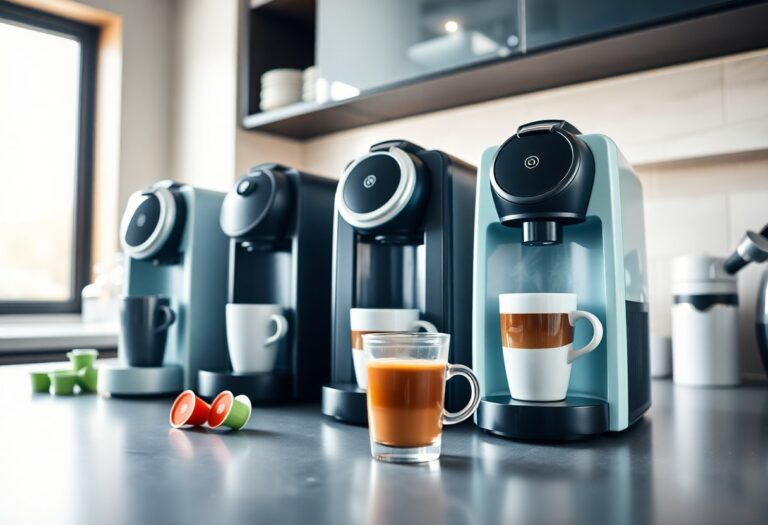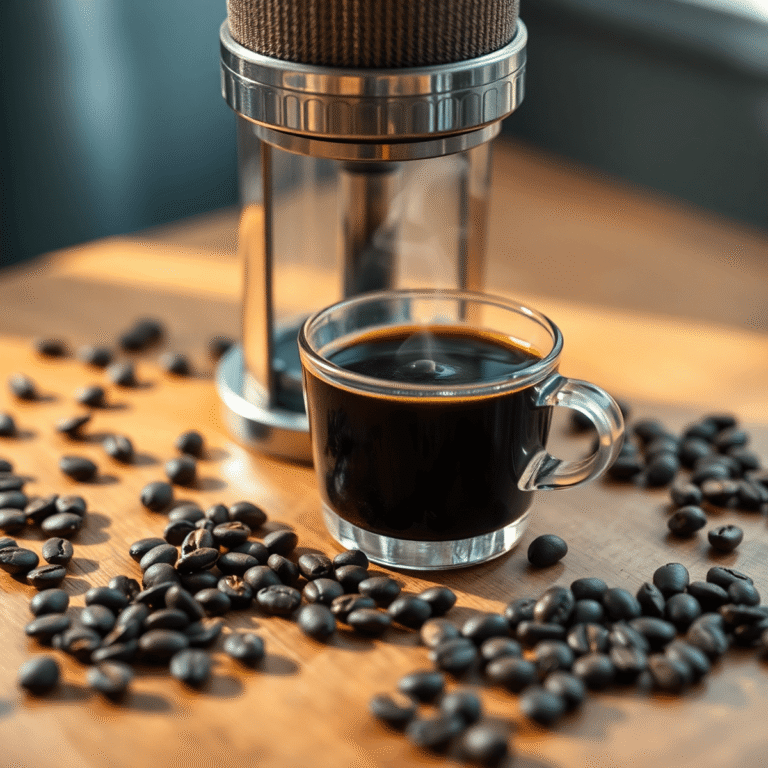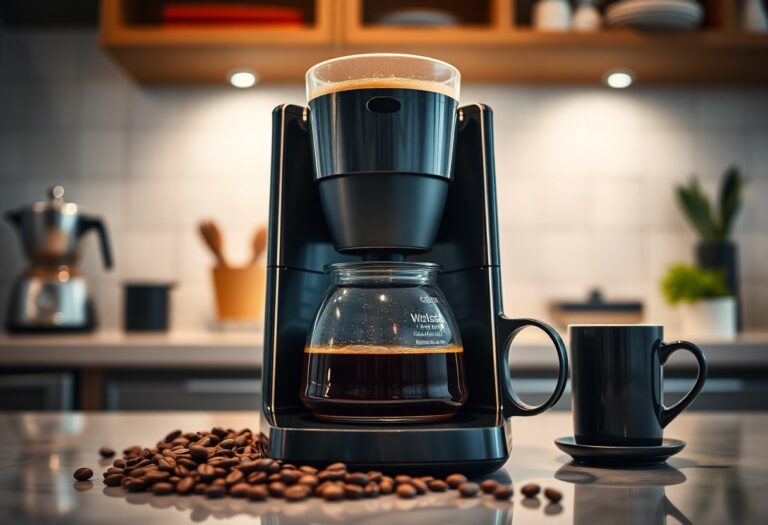What Type of Coffee for a Drip Machine – Brewing Compatibility
With the right selection of coffee, you can elevate your drip coffee experience significantly. Choosing the appropriate coffee grind and roast is key to optimizing your brewing process and flavor extraction. Remember that coarsely ground beans may not yield the desired results in a drip machine. For the best outcomes, you want a medium grind for compatibility and consistency. Additionally, exploring roast types can enhance your brewing, with lighter roasts offering unique flavors. For detailed insights on grind recommendations, check out this resource on Coffee Grind Size.
Key Takeaways:
- Coarse to medium grind coffee works best in drip machines for optimal extraction.
- Freshly roasted beans should be used to enhance flavor; check roast dates for maximum quality.
- Choose high-quality coffee beans that suit your taste preferences, including blends or single-origin options.
- Water quality and temperature significantly affect the brewing process—aim for filtered water heated to around 195°F to 205°F.
- Consistency in coffee-to-water ratio is key; typically, a ratio of 1:15 to 1:18 yields a balanced cup.

Choosing the Right Coffee Bean for Drip Machines
Identifying the best coffee beans for your drip machine can significantly enhance your brewing experience. You’ll want to focus on selecting beans that align with your taste preferences and the extraction process of the machine. Freshness and quality are paramount; seek out specialty coffees and consider their origins, roast types, and flavors to tailor your daily brew perfectly to your liking.
The Impact of Bean Origin: Flavor Profiles and Characteristics
Bean origin profoundly influences flavor profiles and characteristics. For instance, Central American coffees, such as those from Guatemala, often present bright acidity and citrus notes. In contrast, South American beans, particularly from Colombia, tend to offer a balanced sweetness with mild flavor additions. African beans, like Ethiopian, frequently provide floral aromas and fruity undertones. Exploring different origins allows you to discover a diverse spectrum of taste.
Roast Level Considerations: Light, Medium, and Dark Roasts
The roast level affects not only flavor but also the overall drinking experience. Light roasts retain more of the original coffee’s innate flavors and acidity, offering bright, fruity notes. Medium roasts strike a balance, with a nuanced combination of acidity and body. Dark roasts tend to introduce richer, deeper flavors, often with hints of chocolate and caramel, but can lack some of the delicate nuances found in lighter roasts.
Focusing on roast levels can guide you in selecting the right coffee for your drip machine. For a light roast, consider coffees labeled as “city” profiles, showcasing the bean’s purity. Medium roasts, like “full city” or “American,” provide a rounder flavor that appeals to a broader audience. Dark roasts, such as French or Italian, attract drinkers who prefer bold and robust characteristics. Knowing your palate will help you determine which roast level complements your brewing style and enhances your daily ritual.
Grinding: The Key to Perfect Extraction
To unlock the full flavor potential of your coffee, the grind size plays a pivotal role in the extraction process. A drip coffee machine requires a medium grind that allows water to flow through the coffee grounds evenly, ensuring optimal flavor extraction. If the grind is too fine, you risk over-extraction, leading to bitterness, while a too-coarse grind can result in under-extraction, giving you a weak and sour cup. Striking the right balance is vital for achieving that perfect cup of coffee.
Grind Size and Its Role in Brewing Quality
The grind size directly influences the extraction process, dictating how quickly water interacts with the coffee grounds. For drip machines, a medium grind, resembling granulated sugar, promotes a balanced extraction. A finer grind may muddy the taste, while coarser grounds can leave your coffee weak and flat. Optimal brew time and grind size alignment yield a satisfying, well-rounded flavor profile.
When to Grind: Freshness vs Consistency
Freshly ground coffee beans preserve vital oils and flavors, enhancing your brew’s quality. However, consistency in grind size is just as important. Grinding your beans right before brewing ensures maximum freshness, while a uniform grind prevents hot spots during extraction that can negatively affect flavor. Balancing these factors leads to richer coffee without sacrificing quality.
Grinding immediately before brewing caters to the freshness aspect, capturing the vibrant flavors and aromas that dissipate quickly in whole beans. Pre-ground coffee lacks the intensity found in freshly ground beans due to exposure to air. Nevertheless, using a reliable grinder capable of delivering a consistent grind helps eliminate variability, ensuring each batch is brewed with the same depth of flavor and strength. Some coffee enthusiasts opt for a burr grinder to achieve the precise grind required, taking into account that each type of bean may demand slight adjustments. This methodology ultimately caters to your palate, providing a delightful coffee experience every time.
Brewing Parameters: Optimizing Your Drip Machine Settings
Maximizing the potential of your drip coffee involves fine-tuning key brewing parameters, which are important for producing a consistently delicious cup. Adjusting factors such as water temperature and brewing time allows you to personalize your coffee experience. Understanding how these elements interact with your specific blend can lead to better flavor extraction, ensuring each cup meets your taste preferences.
Water Temperature: Finding the Sweet Spot for Extraction
| Recommended Temperature | Effect on Coffee |
|---|---|
| 195°F to 205°F | Optimal extraction, balanced flavors |
| Below 195°F | Under-extraction, sour notes |
| Above 205°F | Over-extraction, bitter flavors |
Achieving the right water temperature enhances extraction efficiency, influencing the overall taste. Staying within the 195°F to 205°F range promotes a balanced flavor profile, allowing the full spectrum of aromas and tastes to develop. Deviating from this range could lead to undesirable results where sourness or bitterness masks the true essence of your chosen beans.
Brewing Time: Balancing Flavor and Strength
Brewing time significantly impacts the strength and flavor intensity of your coffee. The ideal brew time for drip machines typically ranges from 4 to 6 minutes. This ensures that just enough flavor compounds are extracted without overpowering the brew with bitterness or undesirable notes, creating a harmonious cup.
Fine-tuning brewing time allows you to cater to your preferred flavor profile. If you enjoy a richer, more robust cup, extending the brewing time closer to the upper limit of 6 minutes can enhance the extraction of oils and flavors. Conversely, if you prefer a cleaner taste with lighter notes, staying near the 4-minute mark will prevent over-extraction. Experimenting within this timeframe can lead to a customized coffee experience that aligns with your specific preferences.

Additives and Enhancements: Elevating the Coffee Experience
Enhancing your coffee goes beyond the brewing process; it involves a careful selection of additives that can elevate your experience. Whether you enjoy a rich, black cup or a creamy latte, the right combination of sweeteners and creamers can transform your favorite brew into a personal delight. Experimenting with various flavors, from hazelnut to vanilla, allows you to customize each cup to match your mood, all while complementing the specific beans you’ve chosen.
Sweeteners and Creamers: Compatibility with Different Beans
Your choice of sweeteners and creamers can make a significant impact on the overall flavor profile of your coffee. Light-bodied beans, such as a Costa Rican or Ethiopian, pair well with subtle sweeteners like agave nectar or low-fat creamers, allowing their inherent brightness to shine. In contrast, heavier beans like Sumatra or French roast thrive with stronger boosters, such as whole milk or flavored creamers, which can balance out the rich, robust flavors.
Flavor Infusions: How to Experiment Safely
Infusing flavors into your coffee requires finesse and care. Starting with a small quantity of flavored syrups or natural spices, like cinnamon or nutmeg, will help you gauge the impact on your coffee without overwhelming the base flavor of your beans.
For effective flavor infusion, consider using just a few drops of flavored syrup in your coffee first, and then adjust gradually based on your taste preference. You can also experiment with adding fresh herbs, like mint, or citrus peels, which can enhance your coffee without muddying the primary flavor. Remember to maintain balance; some flavors like vanilla extract can overpower lighter roasts, while richer beans may hold up to bolder flavors. Make notes on your combinations to refine your preferences over time, creating a personalized coffee experience tailored just for you.
Maintenance Matters: Ensuring Optimal Performance
Regular maintenance significantly impacts the longevity and efficiency of your drip coffee machine. Neglecting upkeep can lead to inconsistent brewing and unpleasant flavors in your cup. Incorporating routine tasks like descaling and cleaning not only enhances the taste of your coffee but also safeguards the internal components against damage. By dedicating a bit of time to your machine’s care, you’ll ensure that each brew delivers the quality and richness you expect.
Cleaning Your Drip Machine: An Essential Habit
Establishing a cleaning routine for your drip coffee machine is vital for preserving its performance. Accumulated coffee oils and minerals can interfere with the brewing process, resulting in off-flavors and decreased efficiency. A simple vinegar and water solution can be effective in descaling and eliminating residues. Aim to clean your machine every month or more frequently if you use it daily. This vital habit can dramatically improve the taste and quality of your daily cup.
Understanding Water Quality and Its Effects on Coffee
The quality of the water you use significantly affects the outcome of your coffee. Hard water, which contains high levels of minerals, can lead to mineral buildup within your machine, affecting performance and flavor. Conversely, using distilled or overly purified water can strip vital minerals that enhance the coffee’s taste profile. Ideally, aim for water with balanced mineral content for optimal extraction and flavor, typically between 50 to 150 mg/L of total dissolved solids, to elevate your brewing experience.
Conclusion
Hence, selecting the right type of coffee for your drip machine plays a significant role in achieving the perfect brew. You should opt for medium to coarse grind coffee that complements the brewing process, ensuring optimal extraction of flavors. Dark roasts can add boldness, while lighter roasts provide brightness. Pay attention to coffee freshness and origin to enhance your experience. By considering these factors, you can elevate your coffee routine and enjoy a delightful cup every time.
FAQ
Q: What type of coffee grounds should I use in a drip machine?
A: For drip machines, it is best to use medium grind coffee. This grind size allows for optimal extraction of flavors during the brewing process. If the coffee is ground too finely, it can lead to over-extraction and a bitter taste. Conversely, coarse grinds may result in under-extraction, yielding a weak flavor. Look for coffee specifically labeled for drip brewing for the best results.
Q: Can I use pre-ground coffee in my drip machine?
A: Yes, you can use pre-ground coffee in your drip machine. Many brands offer pre-ground coffee that’s suitable for drip brewing. However, for the freshest taste, consider grinding your coffee beans just before brewing. This helps preserve the coffee’s natural oils and flavors, enhancing your overall experience.
Q: Does the coffee bean variety affect compatibility with a drip machine?
A: Yes, the type of coffee bean can influence the flavor, aroma, and overall brewing experience. Popular varieties such as Arabica and Robusta can be used in drip machines, but Arabica is often preferred for its sweeter and more nuanced flavors. Experimenting with different varieties can help you discover which ones pair best with your taste preferences.
Q: Are there specific roast levels better suited for drip machines?
A: Yes, while personal preference plays a significant role, medium to dark roasts are often favored for drip brewing due to their pronounced flavors and lower acidity. Light roasts can also work well, but they may require a more precise brewing time to avoid sour notes. Ultimately, the ideal roast depends on your taste and the specific profile you are looking to achieve.
Q: Is flavored coffee compatible with drip machines?
A: Flavored coffee can be used in drip machines. However, keep in mind that flavored coffees are generally made with base beans that might be light, medium, or dark roasted. The flavoring can sometimes obscure the natural characteristics of the coffee. If you enjoy flavored coffee, look for high-quality options for a balanced taste that satisfies your palate while using your drip machine.







